Gun violence soars in Minneapolis amid fallout from George Floyd's death
Minneapolis is grappling with a surge in crime as bodycam video of George Floyd's arrest is released to the public; Mike Tobin reports.
City police departments already running on fumes amid the novel coronavirus pandemic, widespread protests and civil unrest are now struggling with their latest challenge: a surge in violent crime.
While there’s no single answer for the spike in gun violence, experts and officials told the Associated Press that the country is facing a toxic combination of issues this year.
Summers are notoriously higher in crime in most parts of the country, which causes many agencies, such as the New York Police Department, to deploy more officers to patrol the streets during these months. Piled on top of that are this year’s unique circumstances.
As a result of the COVID-19 pandemic, people have not only lost jobs, but loved ones, and have often been cooped up inside under restrictive stay-at-home orders.
“We cannot get used to hearing about children being gunned down in Chicago every weekend."
And tensions between the public and police have come to a boil in the wake of a number of deaths involving Black individuals who were killed by White police officers. Demonstrators have protested police brutality and systematic racism, and called for law enforcement to be defunded. In some cases, what started as a peaceful event devolved into civil unrest and even riots.
“I think it’s just a perfect storm of distress in America," said Atlanta Mayor Keisha Lance Bottoms earlier this month, after a weekend of bloodshed in her city.
Here’s a look at the violent crime statistics in the Georgia city and in other parts of the country.
ATLANTA
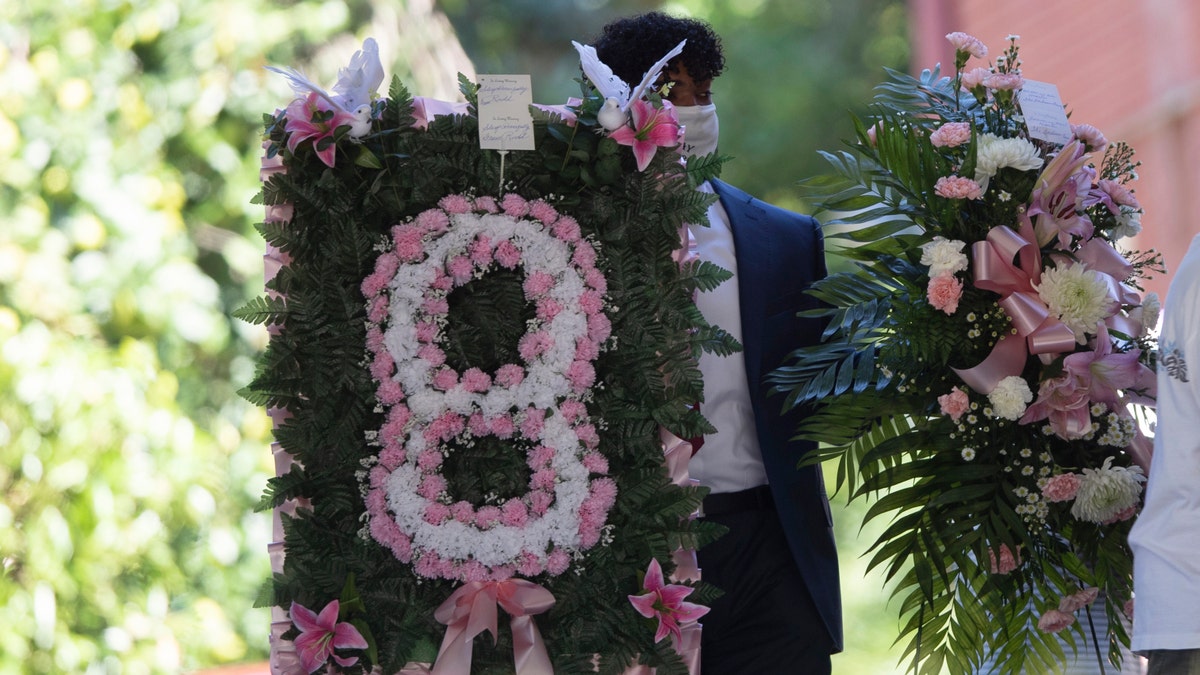
A man carries flowers into a viewing for 8-year-old Secoriea Turner, July 14, 2020, in South Fulton, Ga. (AP Photo/John Bazemore)
Statistics released most recently by the Atlanta Police Department show murders increased by 6 from July 5 to July 11, with 7 this year compared to the single incident reported during that time period in 2019, data provided by the Atlanta Police Department shows.
Over a four-week period ending on July 11, the city saw 17 murders, a 240 percent jump from the five recorded last year. There have been 61 homicides so far this year, compared to the 48 reported in 2019.
As for shootings, APD reported there were 15 shooting incidents involving 32 victims from July 5 to July 11, up from seven shootings with eight victims during that period in 2019.
There were 66 shootings, with 106 victims, during the most recent 28-day period, compared to 26 shootings and 40 victims during the same time last year, police said.
One of the victims was 8-year-old Secoriea Turner, who was shot and killed on the Fourth of July. Secoriea was in a car near a flashpoint of recent protests when at least two gunmen in a crowd of armed people opened fire, police said at the time. Just this week, police announced they had charged a suspect with felony murder.
Turner was killed near the fatal, police-involved shooting of Rayshard Brooks, who was mortally wounded by an officer in a struggle following a field sobriety test. Authorities said the slain man had grabbed an officer’s Taser, but was running away when he was shot.
Police Chief Erika Shields resigned just hours after the shooting.
CHICAGO
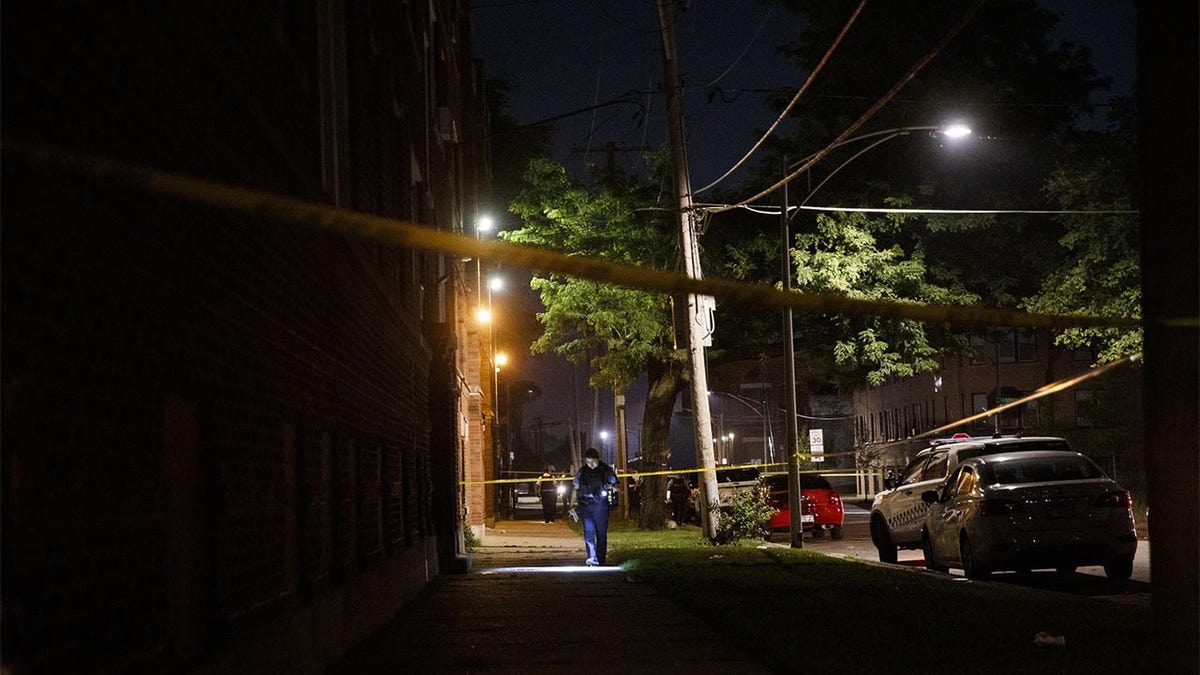
Police work the scene where a 19-year-old man was shot in the 400 block of West 77th Street in Chicago on July 3, 2020. (Armando L. Sanchez/Chicago Tribune/Tribune News Service via Getty Images)
Chicago Police Department reported 31 murders from July 6 to July 12 – a 417 percent increase from the 6 murders recorded during the same time last year, statistics show. The city saw 116 homicides during the most recent 28-day period, compared to the 41 reported in 2019.
There have been 385 murders this year to date, a 48 percent increase year-over-year, data shows.
Police reported 93 shootings from July 6 through 12, an increase of 127 percent compared to the 41 reported last year. There were 414 shootings during the most recent 28-day period, compared to the 209 reported in 2019.
Chicago has seen just shy of 500 more shootings so far this year compared to last, with 1,541 in 2020 compared to 1,059 in 2019. The police department does not include the number of shooting victims on its weekly crime reports.
CHICAGO POLICE TRYING TO COMBAT VIOLENCE LIMITED BY POLITICS-DRIVEN POLICY: FORMER CHIEF
The Illinois city’s July 4th weekend was particularly grim.
One of Chicago’s bloodiest holiday weekends in memory ended with 17 people fatally shot, including a 7-year-old girl and a 14-year-old boy, and 70 more wounded, despite a concerted effort to quell the violence with an additional 1,200 police officers on the streets.
“We cannot get used to hearing about children being gunned down in Chicago every weekend,” Police Superintendent David Brown said shortly after the spate of violence.
Brown suggested at the time that a major hurdle was the failure of the county’s criminal justice system to keep violent offenders behind bars.
INFANT AMONG 3 SHOT IN CHICAGO, SUSPECTS IN CUSTODY: POLICE
He also pointed to a drastic reduction in the number of inmates in the county jail, saying it has left Chicago and other communities at greater risk of violent crime. Even before the coronavirus prompted the release of more than 1,600 detainees, an order to judges to set bail amounts that defendants can afford resulted in a reduction of 1,500 detainees in 2017 alone.
HOUSTON
Murders in Houston have increased by 37 percent, from 140 in 2019 to 178 this year, according to a July 8 report by KTRK-TV.
Police Chief Art Acevedo told the outlet homicide numbers will reach a five-year high if incidents continued to be reported at the current rate. Acevedo said at the time that the department was particularly wary of drug trafficking and gang activity, and said statistics showed an increase in drug-related murders.
Speaking about bail reform in the city, Acevedo told KTRK: "At the end of the day, when we see people going in one door and out the other door and recommitting violent crimes while they are out on bond, that is a problem we need to look at.”
Acevedo also serves as the president of the Major Cities Chiefs Police Association.
He told Yahoo Finance he believed the uptick in murders nationwide was caused by a “perfect storm,” a mix of desperate criminals, such as drug traffickers who are having a hard time, and the economic impacts of the COVID-19 pandemic.
“It’s all of the above, plus the fact in the last few years we’ve been seeing criminal justice reform, that we support as police chiefs, going from a mindset of, ‘We should focus on violent criminals,’ to now, ‘We should coddle everybody not just low-level misdemeanors and non-violent suspects, but even violent individuals.’ I think we’re starting to see the impact across the nation.”
LOS ANGELES
The California city, which boasts a population of more than 4 million people, has seen a recent surge in violence, with 49 shootings and 14 fatal shootings from July 8 to the end of June, according to KABC-TV.
There were 19 murders from June 21 to July 5, compared to nine in the same period in 2019, the Los Angeles Times reported.
The Los Angeles Police Department’s statistics show there have been 151 murders so far this year, an increase of 12.7 percent compared to the 134 reported at this time in 2019. Shooting numbers, however, were down.
According to the LAPD’s year-to-date crime data, there have been 1,198 “shots fired” incidents, with 524 shooting victims, compared to the 1,204 incidents and 549 victims reported for 2019.
Amid tension between the police department and activists over its use-of-force tactics, city leaders voted to slash the LAPD's nearly $2 billion budget by $150 million, reducing the number of officers to a level not seen for more than a decade.
Police Chief Michel Moore told local outlet KCRW the city had been “asked for far too long to do too much." City officials are pushing for unarmed city employees to respond to certain calls, instead of police.
He stressed to the outlet that 2019 had some of the lowest murder numbers the city had seen since the 1960s.
NEW YORK CITY
The number of shootings skyrocketed in New York City with a 277 percent increase of 49 incidents from July 6 to July 12, compared to the 13 reported during the same time last year. The New York Police Department reported 60 victims from this year’s incidents during that time frame, compared to the 17 reported during the period last year, crime data shows.
The most recently reported 28-day period recorded 239 shootings with 318 victims, compared to the same time last year, when there were 77 shootings and 97 victims, according to police data.
There have been 777 shooting victims, from 634 shootings, since the start of this year, according to most recently available data. At the same time last year, there had been 456 victims from 394 incidents.
However, there were 4 fewer murders from July 6 to July 12 than the 10 reported during the same time last year.
During the 28-day period, the city saw an increase in homicides, from 38 in 2019 to 41 in 2020. As of July 12, there had been 203 murders so far this year, 38 more than last year at this time.
Police said 97 percent of June’s shooting victims were people of color.
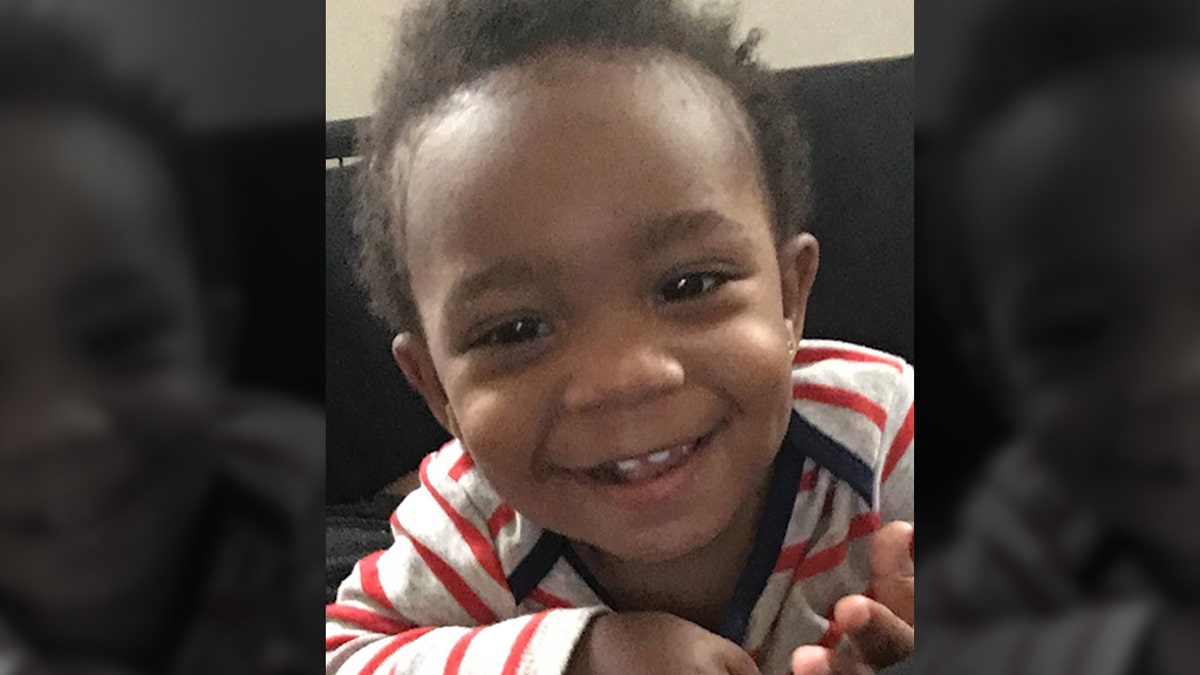
One of those victims was 1-year-old Davell Gardner, Jr., who was with his mother at a family cookout late Sunday night when he was fatally shot by a gunman who opened fire across a neighborhood park
One of those victims was 1-year-old Davell Gardner, Jr., who was with his mother at a family cookout late Sunday night when he was fatally shot by a gunman who opened fire across a neighborhood park.
At a news conference earlier this month, NYPD Chief of Department Terence Monahan said the city had just experienced "one of the most violent weekends” in recent history “and one of the most violent Junes we've had in recent history."
Emboldened criminals feel “that the cops can’t do anything anymore, that no one likes the police, that they can get away with things, that it’s safe to carry a gun out on the street,” Monahan said.
The NYPD also disbanded its plainclothes anti-crime unit, which was tasked with taking illegal guns off the street after critics said it was too aggressive.
Monahan stressed that there was no single reason for the uptick in violence.
"It starts with bail reform that began in January of this year. It goes on with the district attorneys' reluctance to prosecute quality-of-life crimes and some City Council Members who don't want us to deal with quality of life at all," he said. “And, in March and April, we saw prisoners, many who were convicted prisoners and parolees, released from Rikers due to COVID... On top of all this, the courts have been shut down and many individuals who are indicted by a grand jury on gun charges are not in jail but instead are free awaiting for the courts to open up. And, hundreds more criminals who have been arrested for possession of a gun have not yet been indicted by a grand jury because the courts are not in session. They, too, are not behind bars."
The New York Post reported that NYPD’s own crime data showed the crime spike could not be solely attributed to bail reform.
Monahan himself was one of a group of officers that was attacked while making an arrest at a protest on the Brooklyn Bridge earlier this week. Three officers suffered serious injuries, police said, and Monahan suffered an injury to his hand.
PHILADELPHIA
As of Wednesday night, the Philadelphia Police Department reported 224 murders so far this year, a 25 percent increase compared to the 178 reported at the same time in 2019, statistics show.
Shooting numbers have also spiked. By July 12, shooting incidents increased by 55 percent, from 1,018 at this time last year to 1,578 so far this year, according to police data. There was also a 31 percent jump in shooting victims, from 720 to 946.
PORTLAND, ORE.

Agents from different components of the Department of Homeland Security are deployed to protect a federal courthouse in Portland, Ore., on Sunday, July 5, 2020. (Doug Brown via AP)
As of July 13, Portland Police reported 42 shootings so far for the month, compared to past months that recorded an average of 32 shooting incidents, with none surpassing 40, OregonLive.com reported.
“Each of these numbers represents a human being, and we must not lose sight of that,” said Portland Police Chief Chuck Lovell during a virtual press conference at the time, according to the outlet.
Murders also flared in the first dozen days of July, with five people killed in two days, but the city so far recorded 1 less murder this year than it had at this time last year, with 16 in 2020 compared to 17 in 2019, OregonLive.com reported.
“This is the city we live in,” Wheeler added. “Portlanders, our neighbors, are being hurt by this violence.”
The police department had recently disbanded its Gun Violence Reduction Team, the 34-person unit tasked with working these types of crimes, according to the outlet. The city also reallocated the $5.7 million in funds for the unit to instead use toward Portland Street Response and the city budget.
Portland has reportedly seen as many as 50 days of protests that have increasingly targeted the federal courthouse.
The protests in Oregon’s largest city following the police killing of George Floyd in Minneapolis have often devolved into violent clashes between smaller groups and the police. The unrest has caused deep divisions in a city that prides itself on its activism and progressive reputation.
“Each night, lawless anarchists destroy and desecrate property, including the federal courthouse, and attack the brave law enforcement officers protecting it,” Department of Homeland Security Acting Secretary Chad Wolf wrote in a scathing statement earlier this week.
Demonstrators set fires, launched fireworks and sprayed graffiti on public buildings, including police precincts and the U.S. courthouse. Federal and local authorities have responded with tear gas and dozens of arrests.
"Instead of addressing violent criminals in their communities, local and state leaders are instead focusing on placing blame on law enforcement and requesting fewer officers in their community. This failed response has only emboldened the violent mob as it escalates violence day after day,” Wolf's statement said.
Federal officers recently sent to Portland by President Donald Trump have escalated tensions in the past two weeks, particularly after an officer with the U.S. Marshals Service fired a less-lethal round at a protester’s head on July 11, critically injuring him.
SEATTLE
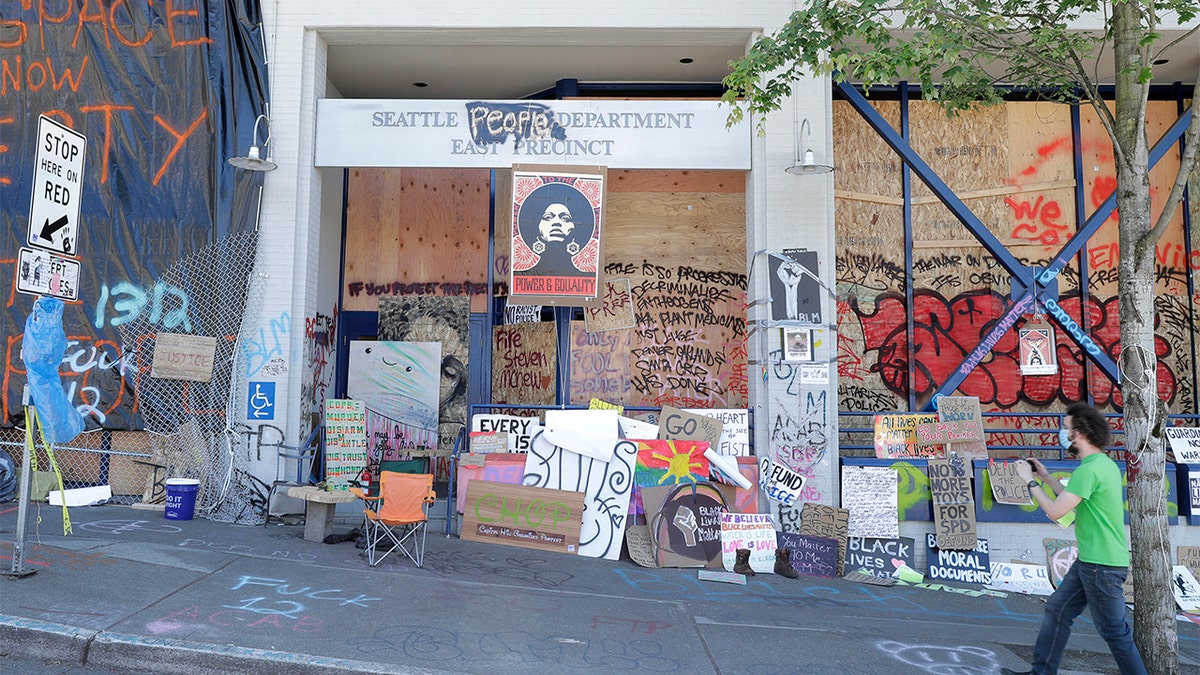
A person takes a photo of the Seattle Police East Precinct building, Monday, June 22, 2020, inside what has been named the Capitol Hill Occupied Protest zone in Seattle. (AP Photo/Ted S. Warren)
Seattle saw a slight spate of violence in June, which officials have attributed in part to a police-free autonomous zone.
Police moved in to clear the “Capitol Hill Organized Protest” zone on June 1 following a pair of fatal shootings in the area just east of downtown. The group had occupied several blocks around a park for about two weeks after police abandoned a precinct station following standoffs and clashes that were part of the nationwide unrest over the killing of George Floyd in Minneapolis.
SEATTLE POLICE CHIEF SAYS 50% BUDGET CUT WOULD BE 'TRAGIC DECISION' AND IS POLITICALLY MOTIVATED
“The recent public safety threats have been well documented," Mayor Jenny Durkan said at a news conference that day. “These acts of gun violence resulted in the tragic deaths of two teenagers, with multiple others seriously wounded. Despite continued efforts to de-escalate and bring the community together, this violence demanded action."
A 19-year-old man was fatally wounded and a second was critically injured in an early-morning shooting on June 21.
Then, on June 29, two other teenagers, ages 16 and 14, were shot while within the zone, according to The New York Times. The eldest victim did not survive.
It was the fourth shooting within the protest zone in 10 days, The Times reported.
Police Chief Carmen Best said in addition to the fatal shootings, robberies, assaults, violence and property crimes had occurred in the area.
“The CHOP has become lawless and brutal,” Best said in a statement provided to Reuters at the time. “Four shootings — two fatal — robberies, assaults, violence and countless property crimes have occurred in this several-block area.”
Meanwhile, protesters said they should not be blamed for the violence in the area.
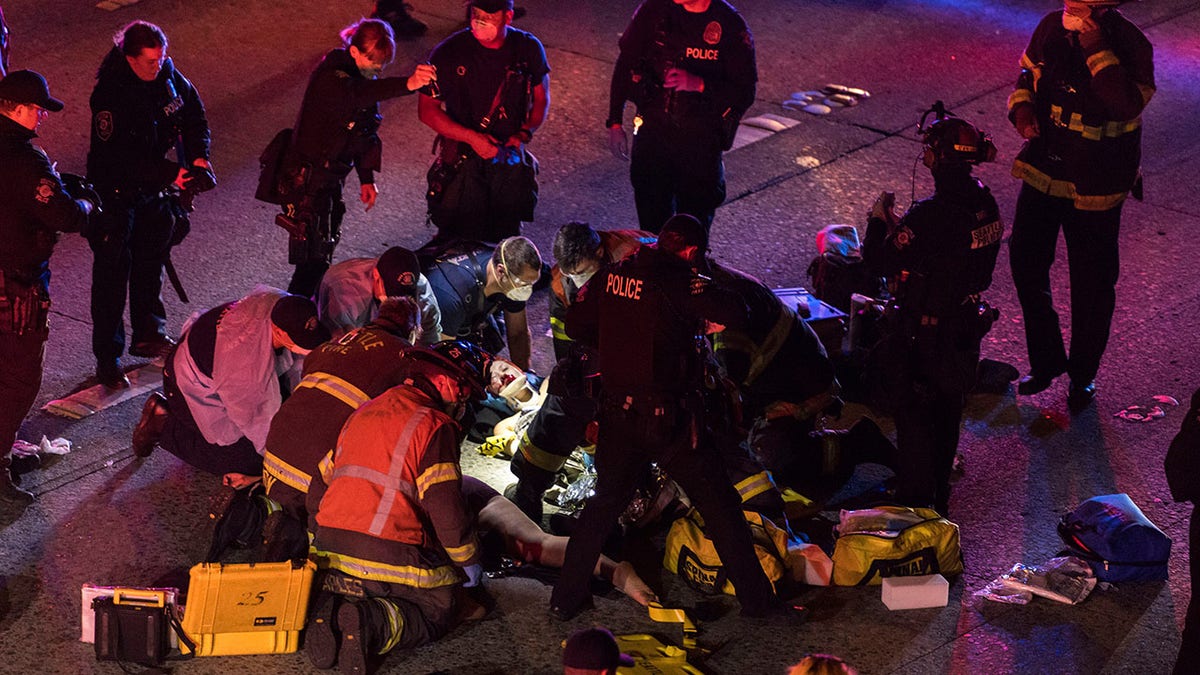
Emergency workers tend to an injured person on the ground after a driver sped through a protest-related closure on the Interstate 5 freeway in Seattle, authorities said early Saturday, July 4, 2020. (James Anderson via AP)
On July 4, a man hit two protesters with his car, killing one, while driving on a Seattle freeway that was closed for Black Lives Matter demonstrations.
The King County Prosecuting Attorney’s office charged Dawit Kelete, 27, with vehicular homicide, vehicular assault and reckless driving.
Kelete drove around vehicles that were parked on Interstate 5 to protect the protesters, hitting two people at about 1:40 a.m. Saturday, according to the Washington State Patrol. Summer Taylor, a 24-year-old veterinary clinic worker, died that night.
CLICK HERE TO GET THE FOX NEWS APP
Reports of violence in Seattle were otherwise slightly fewer than they were last June, when 371 instances of violent crime were recorded, compared to this June, which has seen 358, according to Seattle Police Department crime statistics.
There have been 17 murders in Seattle so far this year, according to the data. There were 28 total murders in the city in 2019.
The Associated Press contributed to this report.




